Crypto Institutional Interest: What Coins Are Wall Street Looking At?
Cryptocurrencies' journey from a fringe fascination to being too sexy to be ignored has been well chronicled.
Decentralized digital currencies have now captured the attention of institutional giants, shifting the narrative from scepticism to a more receptive exploration of the sector. Major institutions, once onlookers from the sidelines, are now actively seeking ways to offer investment products tied to this digital asset class.
One undeniable catalyst for this mood shift is the eye-popping return on investment offered by crypto. Bitcoin, the first and still the largest coin, has demonstrated extraordinary returns that have outpaced traditional investment vehicles. Bitcoin has even been hailed as “the best investment of the decade”.
While retail investors were already on board the crypto hype train since the sector's nascent days, these mouth-watering returns have promoted institutional players to reconsider their initial hesitancy.
This article will explore Wall Street's increasing interest in crypto, which coins are favoured by major institutions and what's next when it comes to institutional adoption.
Significance of Wall Street's Attention to Crypto
Wall Street's interest in crypto brings about major implications for this still-new asset class, particularly in terms of legitimacy and mainstream acceptance. This interest from traditional financial heavyweights helps contribute to the broader validation of digital assets in several ways.
Legitimization of the Crypto Market
Cryptocurrencies have long been dismissed as speculative and volatile, but Wall Street's attention brings a level of acknowledgement.
- Due Diligence: Institutional investors, famous for their due diligence processes, are now researching and analyzing the crypto market. This leads to two things — a better understanding of the risks and opportunities within the space, and reinforcing the notion that cryptos deserve to be considered within the broader financial landscape.
- Integration into Traditional Investments: Wall Street's adoption of crypto comes with integration into traditional investment strategies. Make no mistake — this isn't experimental but reflects a measured approach to diversification and risk management.
- Regulatory Compliance: Traditional institutions navigating the crypto market are doing so with a keen eye on regulatory compliance. The involvement of traditional players necessitates adherence to existing financial regulations, pushing the crypto market towards a more regulated and transparent environment.
Increased Market Credibility
The fact that traditional financial institutions are investing in cryptocurrencies adds credibility to this asset class.
- Validation: The participation of institutional heavyweights injects a potent dose of validation. Established names like BlackRock (the world's largest asset manager) with a storied history reassure fellow institutional investors.
- Trust: Institutional investors often have a reputation for thorough due diligence, risk management and compliance. Their endorsement of the crypto market instils confidence and attracts investors who may have been hesitant.
- Broader Acceptance: Wall Street's interest in crypto encourages a broad spectrum of investors to consider digital assets as part of their investment portfolios. The seal of approval from institutional players helps break down barriers to entry, making digital tokens more palatable for investors who traditionally favoured conventional asset classes.
- Market Maturation and Stabilization: Wall Street is here to stay! The presence of institutional investors, known for their long-term perspectives and stability, has the potential to mitigate some of the extreme volatility historically associated with digital assets.
- Creation of Financial Products: The development of crypto-related financial products by Wall Street institutions contributes to increased market credibility. As we'll discuss later, products such as crypto ETFs and futures contracts offer investors regulated and familiar investment vehicles.
Institutional Capital Inflow
Wall Street's foray into the crypto market brings with it a significant inflow of institutional capital.
- Market Liquidity and Depth: One of the immediate impacts of institutional capital inflow is the substantial increase in market liquidity and depth.
- Diversification of Institutional Portfolios: As institutional investors seek to balance risk and return, the inclusion of digital assets provides a non-correlated asset class, offering potential diversification benefits that extend beyond traditional stocks and bonds.
- Impact on Market Dynamics: The sheer scale of institutional capital can significantly impact market dynamics. Large trades and investments from institutions can influence price trends, shape market sentiment, and, in some cases, trigger broader market movements.
Overall, institutions are optimistic yet cautious. Among those currently invested in digital assets, the majority allocate 1% to 5% of their portfolios to digital assets or related products. A substantial 76% of respondents with digital asset investments indicate allocations below 5%, while only a minimal 3% allocate above 20% of their portfolios to this asset class, according to EY.
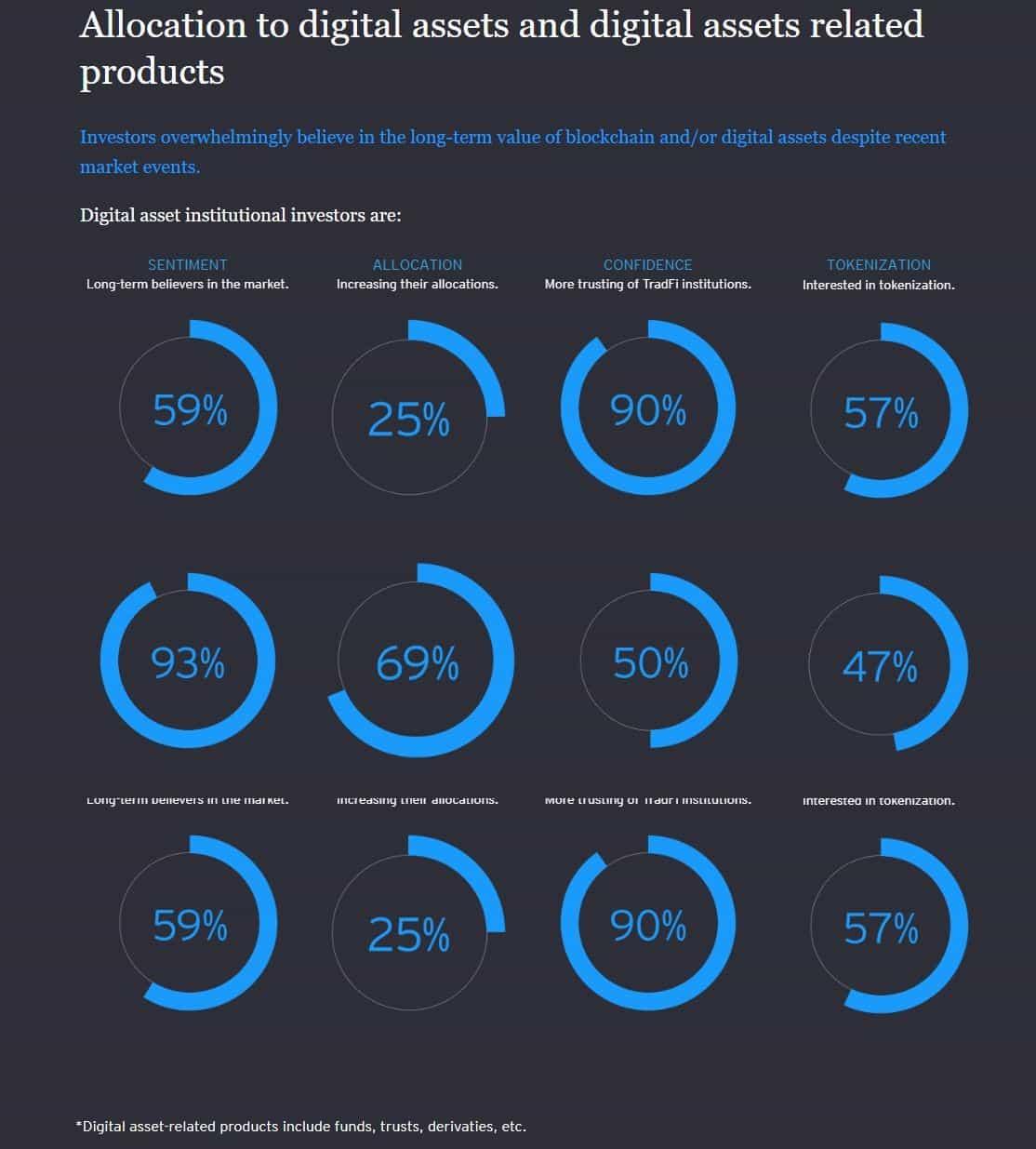
One popular approach to investing is a strategy known as Modern Portfolio Theory, which aims to provide the best risk-to-reward ratio. We cover the strategy in detail in our article: How to Use Modern Portfolio Theory to Build a Crypto Portfolio.
Regulatory Evolution
As institutional players allocate money to digital assets, regulators are compelled to reassess and adapt their frameworks to accommodate the complexities of the crypto space. The intersection of TradeFi and decentralized currencies has prompted regulators to come up with a game plan that fosters innovation and mitigates potential risks.
The development of regulatory and legal frameworks in the past year have been instrumental in restoring trust in digital assets. The market resilience, underscored by a pursuit of innovation, sets the stage for regulatory frameworks, which seek to balance risk with opportunity and innovation. - PwC
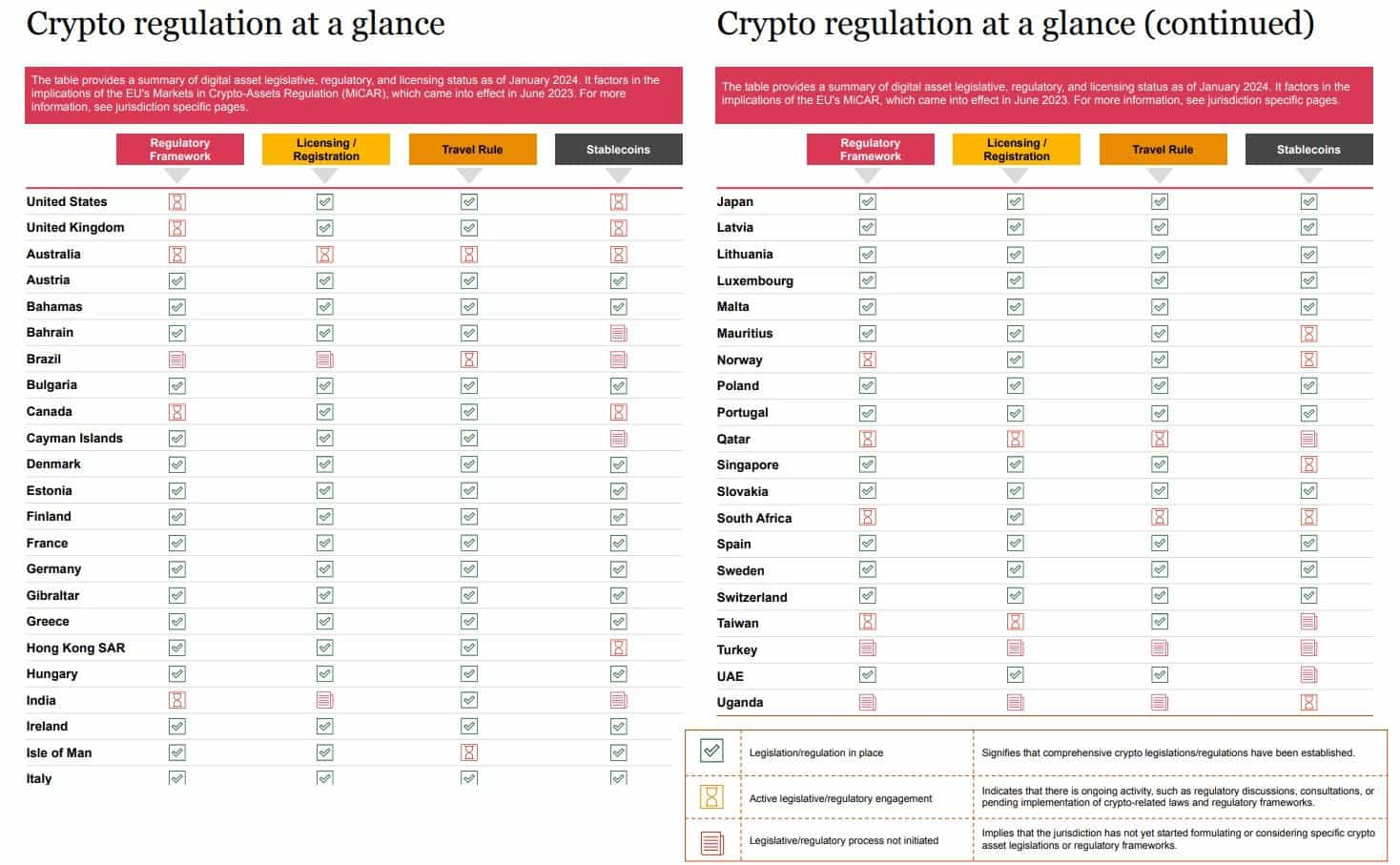
Recent years have witnessed a notable shift from initial regulatory scepticism to a more nuanced approach, with some jurisdictions actively working towards creating comprehensive regulatory frameworks. This, of course, doesn't include the US, where four agencies — the SEC, the Commodity Futures Trading Commission, the Department of Justice, and the Treasury Department's Financial Crimes Enforcement Network (FinCen) — work in tandem to police the sector at their whim amid a lack of clear regulatory guidelines specific to cryptocurrencies.
In 2023, the CFTC brought 47 actions involving conduct related to digital asset commodities, representing more than 49% of all actions filed during the year. The SEC highlighted that 2023 was a “highly productive and impactful year” for its enforcement of crypto-related misconduct.
However, as regulatory clarity emerges, institutional investors would gain a clearer roadmap for their participation, boosting confidence, and paving the way for a more secure and regulated environment in which both the industry and participants can thrive.
For industry players across the globe, 2024 is not just about weathering the storm – it’s about building a foundation for a thriving ecosystem, where clear regulatory guidance acts as the cornerstone of renewed stability. - PwC
Bitcoin: The Pioneer's Enduring Appeal
Bitcoin has not only maintained its status as the largest cryptocurrency but has increasingly become the go-to crypto for institutional adoption. Institutions, once wary of digital assets, have undergone a notable shift in sentiment, with a growing number expressing interest and actively integrating Bitcoin into their investment strategies.
The emergence of investment vehicles, such as Bitcoin exchange-traded funds (ETFs), has provided everyone with a more familiar and regulated means to gain exposure to Bitcoin.
Spot Bitcoin ETFs are all the rage these days. According to Decrypt, more than 15 companies, including BlackRock, WisdomTree and Valkyrie, are awaiting the SEC's approval. If recent headlines are anything to go by, the SEC's blessing is imminent but they've been saying that for years now.
Spot Bitcoin ETFs aren't new by any measure — countries including Canada, Germany, Australia and Switzerland have given their nod to these investment products. If the SEC greenlights these applications, the U.S. would become the 9th country where spot Bitcoin ETFs are incorporated, according to CoinGecko. Overall, there are 22 active spot Bitcoin ETFs offered across the world with a combined $6.01 billion in total assets.
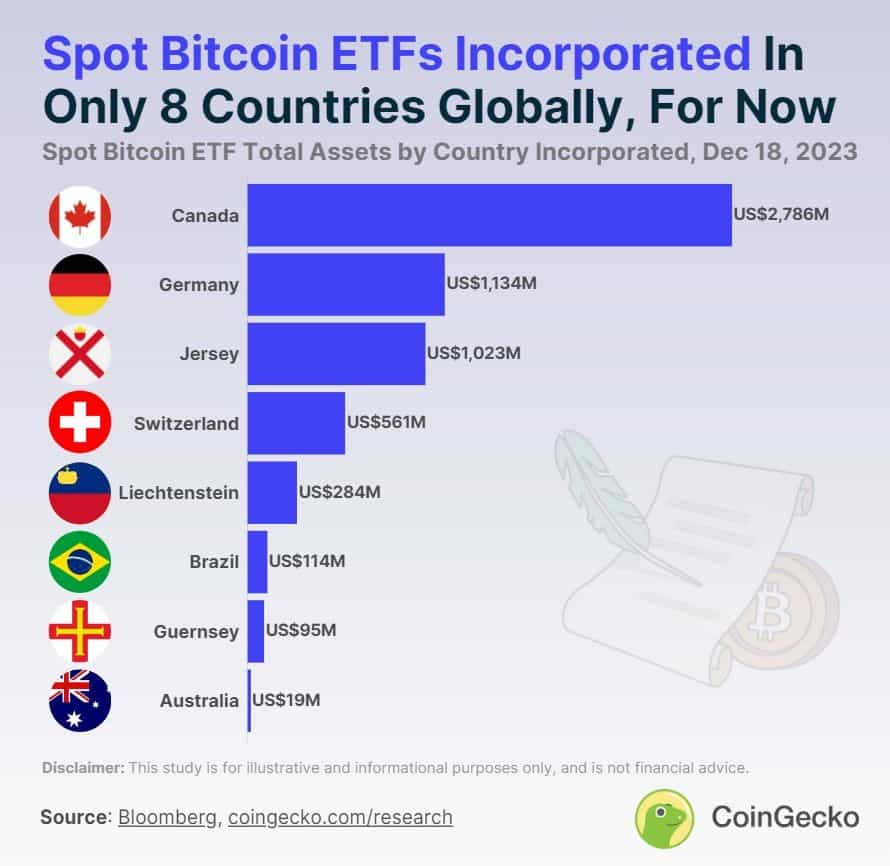
Factors Contributing to Bitcoin's Appeal
With its supply capped at 21 million coins, coupled with its decentralized nature, Bitcoin has been likened to “digital gold" that is considered the currency of the future to some and a store of value to others.
Bitcoin's appeal among institutional investors stems from a combination of attributes unique to the digital currency.
- Institutional Infrastructure: The development of institutional infrastructure, including regulated exchanges, custody solutions, and financial products, has significantly enhanced Bitcoin's appeal. Institutions now have more secure and compliant avenues, reducing the operational and regulatory risks associated with crypto investments.
- Macro-Economic Trends: Bitcoin's decentralized nature and finite supply make it attractive in times of macroeconomic uncertainty. Bitcoin is considered to be a hedge against traditional market fluctuations, especially during periods of economic distress.
- Recognition by Traditional Finance: Bitcoin's increasing recognition by traditional finance players has contributed to its appeal. As established financial entities show interest and integrate Bitcoin into their offerings, it bolsters the perception of Bitcoin as a legitimate and noteworthy investment.
Wall Street is Smitten by Bitcoin's Performance
Bitcoin outperformed 65 tokens in the top 100 cryptos in 2023, according to CoinGecko, increasing by 162.5% to $43,418 from $16,540 since the beginning of the year up to Dec. 28, 2023.
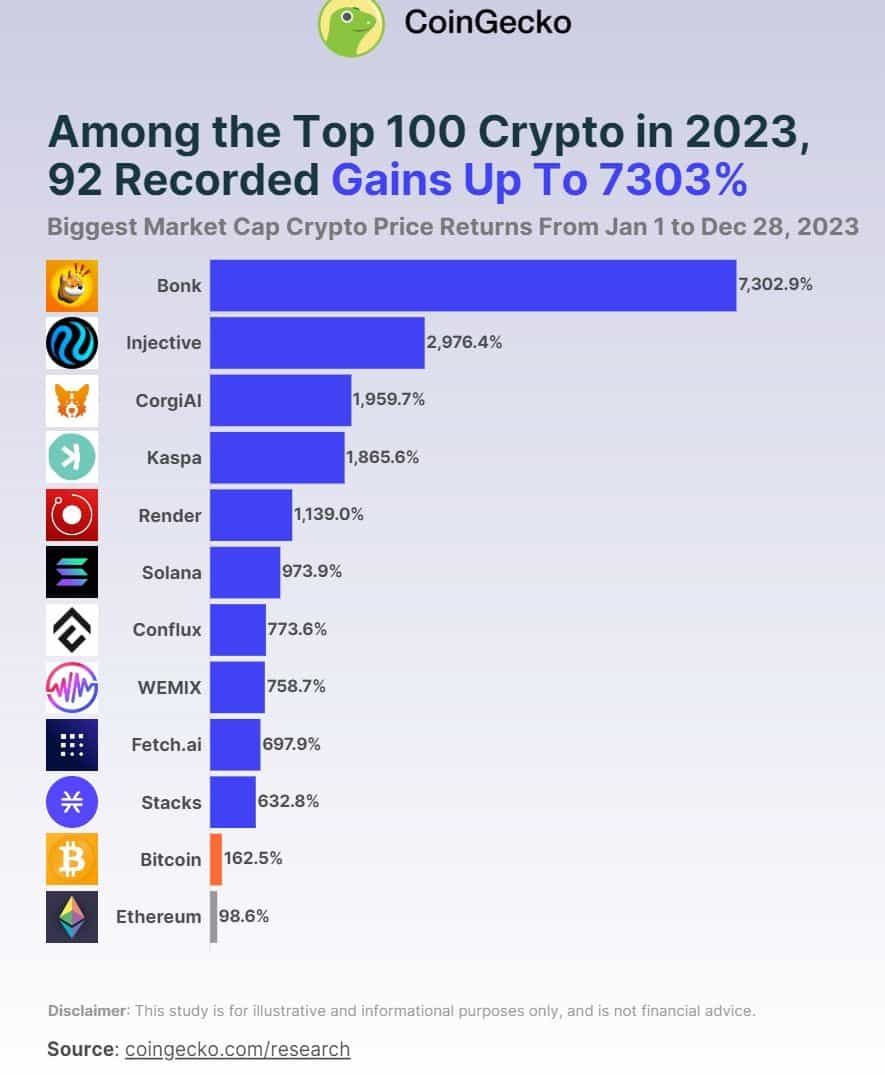
Bitcoin's returns over various timeframes have captured the attention of institutional investors seeking alpha in their portfolios. The digital asset's ability to deliver substantial profits has instilled confidence among Wall Street players and turned many naysayers into supporters.
Bitcoin continued to lead as one of the best-performing assets globally in 2023. According to Glassnode, BTC outperformed both USD and gold denominators:
- BTC vs USD: +141.6%
- BTC vs Gold: +106.6%
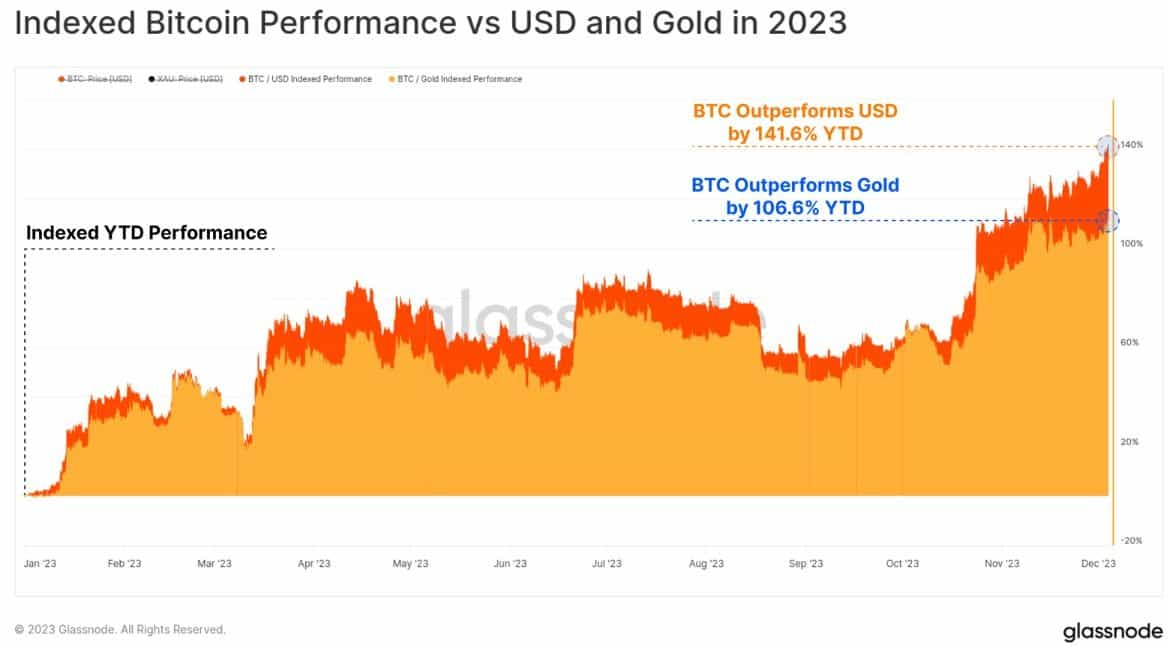
Positive trends like this foster a more favourable environment for other cryptocurrencies, influencing Wall Street sentiment towards the broader crypto space.
For a deep dive into crypto's returns, head over to our article where we pit Bitcoin and stocks across various verticals such as returns, innovation, volatility and adoption.
Ethereum: Beyond Digital Gold
While Bitcoin may have started it all and currently remains the flagship crypto, Ethereum has emerged as a key player capturing institutional interest due to its unique features and versatility.
Institutional Interest in Ethereum
Institutional adoption of Ethereum is gaining momentum. Today, the second-largest crypto enjoys a dominant position in the crypto world thanks to its pioneering smart contracts functionality, market recognition and network effects.
Institutional investors are drawn to Ethereum as a means of expanding beyond traditional assets. The unique features of Ethereum — smart contracts and burgeoning decentralized applications ecosystem — offer a distinct means for diversification.
ZyCrypto quoted Bloomberg as reporting that seven spot Ether ETF filings have been made by companies including Fidelity, Invesco & Galaxy and Grayscale, among others.
Ethereum is a pioneering force in blockchain innovation, and institutional interest is largely fueled by their desire to be part of blockchain technology's transformative journey as the network continues to shape the landscape with its advancements in decentralized finance.
Applications Driving Institutional Attention
There's no question about Ethereum's technological capabilities, but we must delve a bit deeper to understand why it is on Wall Street's radar.
- Decentralized Finance: Ethereum's role as the primary platform for DeFi applications has positioned it as the top dog in the crypto sector. Investors are intrigued by the potential disruption of traditional financial intermediaries and the financial inclusion offered by DeFi protocols.
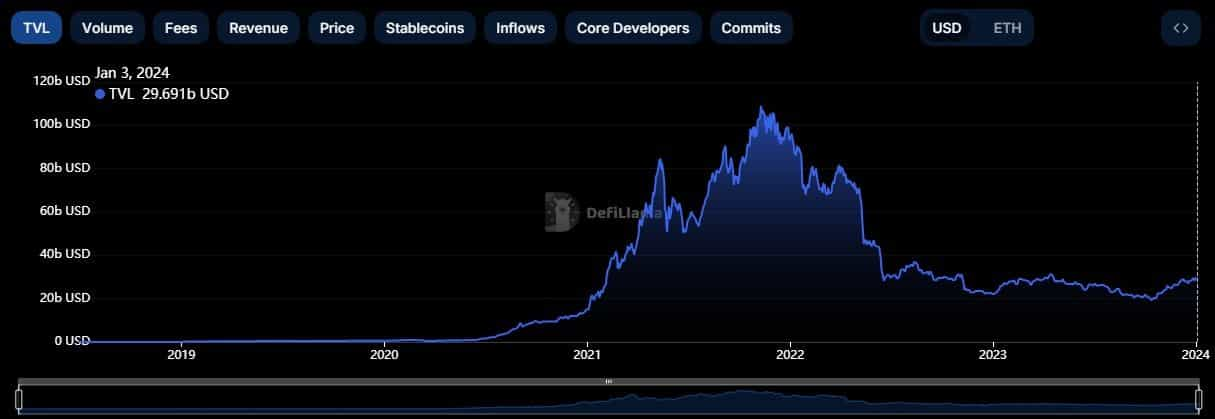
- Non-Fungible Tokens: Thanks to its smart contract functionality, Ethereum is a tour de force in the NFT market as well. In 2022, the NFT market generated sales of over $24.7 billion, and Ethereum claimed the lion's share. Its market share in the NFT space has surpassed 78%. The blockchain houses many of the most sought-after NFT marketplaces, such as OpenSea, Blur, Magin Eden and Castle
- Initial Coin Offerings: Remember the ICO frenzy of 2017 and 2018? Ethereum played a central role in enabling this crowd-funded boom of raising capital. A total of 2,284 initial coin offerings in 2018 raised about $11.4 billion, 13% more than in 2017, with Ethereum claiming 84.29% of the projects. More recent data from 2023 suggests Ethereum captured 72% of all ICOs.
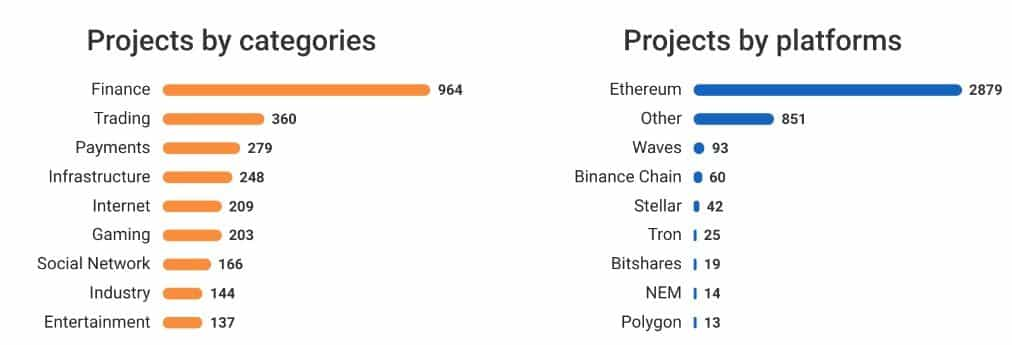
Altcoins on the Radar
It isn't just Bitcoin and Ethereum that have won Wall Street's seal of approval, many institutional investors have set their sights on altcoins (Ethereum is an altcoin too; any coin not called Bitcoin is, in fact).
According to CoinShares, the following digital currencies witnessed inflows (money coming in) in 2023:
- Solana ($167 million)
- Litecoin ($3 million)
- XRP ($18 million)
- Cardano ($14 million)
- Polkadot ($6 million)
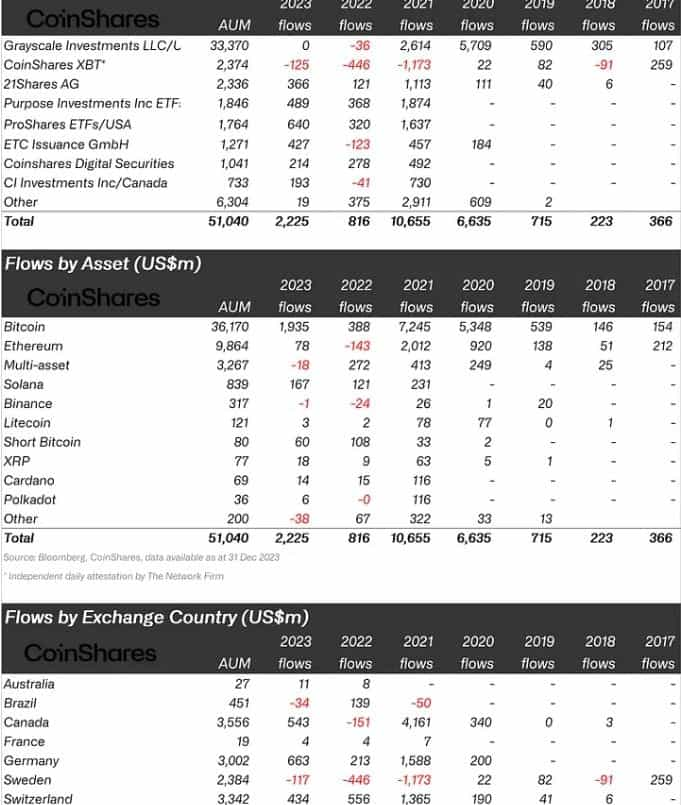
Unsurprisingly, Bitcoin saw the highest inflows at $1.94 billion followed by Ethereum at $78 million. Money flowing into the altcoin sector from institutions can often act as a canary in the coal mine, highlighting which projects are likely to gather more attention as investors, both retail and institutional look to deploy capital in the digital asset space. As the old clichés go “swimming with the whales” and following the “smart money” is often considered a good approach to investing.
All in all, digital asset investment products attracted $2.25 billion of inflows in 2023, representing a 2.7x increase over the previous year.
Much of the recovery was in the final quarter where it became increasingly clear that the SEC was warming up to the launch of Bitcoin spot-based ETFs in the United States. Total assets under management (AuM) has risen by 129% over the year, ending at US$51bn, the highest since March 2022 - CoinShares
Factors Fueling Interest in Altcoins
There are several factors that play a role in steering institutional interest towards specific altcoins.
- Technological Innovations: Cutting-edge features, scalability solutions, and advancements in blockchain technology often serve as compelling factors. For example, Solana, Cardano and Polkadot are considered by many as “Ethereum killers” as they aim to address Ethereum's scalability bottleneck.
- Use Cases: The real-world applications of altcoins are likely a significant driver of institutional interest. Web3 applications, crypto gaming and DApps are some of the verticals unique to blockchain technology. In the real world, the technology can be seen in action in several sectors including banking and finance, healthcare and supply chain to name a few. If this sounds like music to your ears, you'd find our article on use cases of blockchain technology a great read!
- Market Trends: Altcoins don't exist in isolation; they're part of the broader crypto ecosystem. Liquidity, for example, is probably something on institutional investors' minds before they venture into altcoins, so they'll likely stick to coins with high liquidity. Another consideration is likely volatility and these financial giants employ advanced risk models and analytics to anticipate and mitigate potential price swings.
- Partnerships: Collaborations play an important role for not just crypto companies but every corporation. Institutional investors likely analyze strategic alliances formed by altcoins. Solana, for example, struck a partnership with payment processor Visa, which touted its "speed, scalability and low transaction costs." Cardano, on the other hand, has partnerships with the European Investment Bank and the International Finance Corporation, among many others.
Challenges and Concerns
The journey toward widespread institutional involvement is not without its hurdles.
As major financial institutions contemplate integrating digital assets, they must over certain challenges and concerns, ranging from regulatory uncertainties to security apprehensions and the intricacies of altering long-standing perceptions.
Regulatory Uncertainty
Regulatory uncertainty remains a major concern for institutional investors considering entry into the cryptocurrency space. The lack of a standardized regulatory framework introduces a level of ambiguity that may give some institutions pause.
The global regulatory landscape for cryptocurrencies is highly fragmented, with different countries adopting varying approaches. Some nations have embraced cryptocurrencies, providing clear guidelines, while others maintain a restrictive stance. According to PwC, 42 countries either held discussions or passed laws concerning cryptocurrencies in 2023.
The rapid evolution of the crypto market often outpaces regulatory developments. Nevertheless, the lack of clear guidelines complicates compliance efforts for institutions. Addressing regulatory uncertainty requires a concerted effort from all stakeholders.
Crypto companies, financial institutions, and advocacy groups can come together to engage with regulators to advance clear and comprehensive regulatory frameworks.
Security Concerns
The security of digital assets remains a paramount concern for institutions. Instances of hacking and vulnerabilities in the sector have likely forced some institutional investors to stay on the sidelines.
According to CertiK, over $1.8 billion was lost across 751 security incidents in 2023. Interestingly, this represents a decline of 51% from the $3.7 billion lost in 2022. Private key compromises were the most costly attack vector, and BNB Chain experienced the highest number of security incidents. Ethereum saw a total of 224 incidents, totalling $686 million in losses.
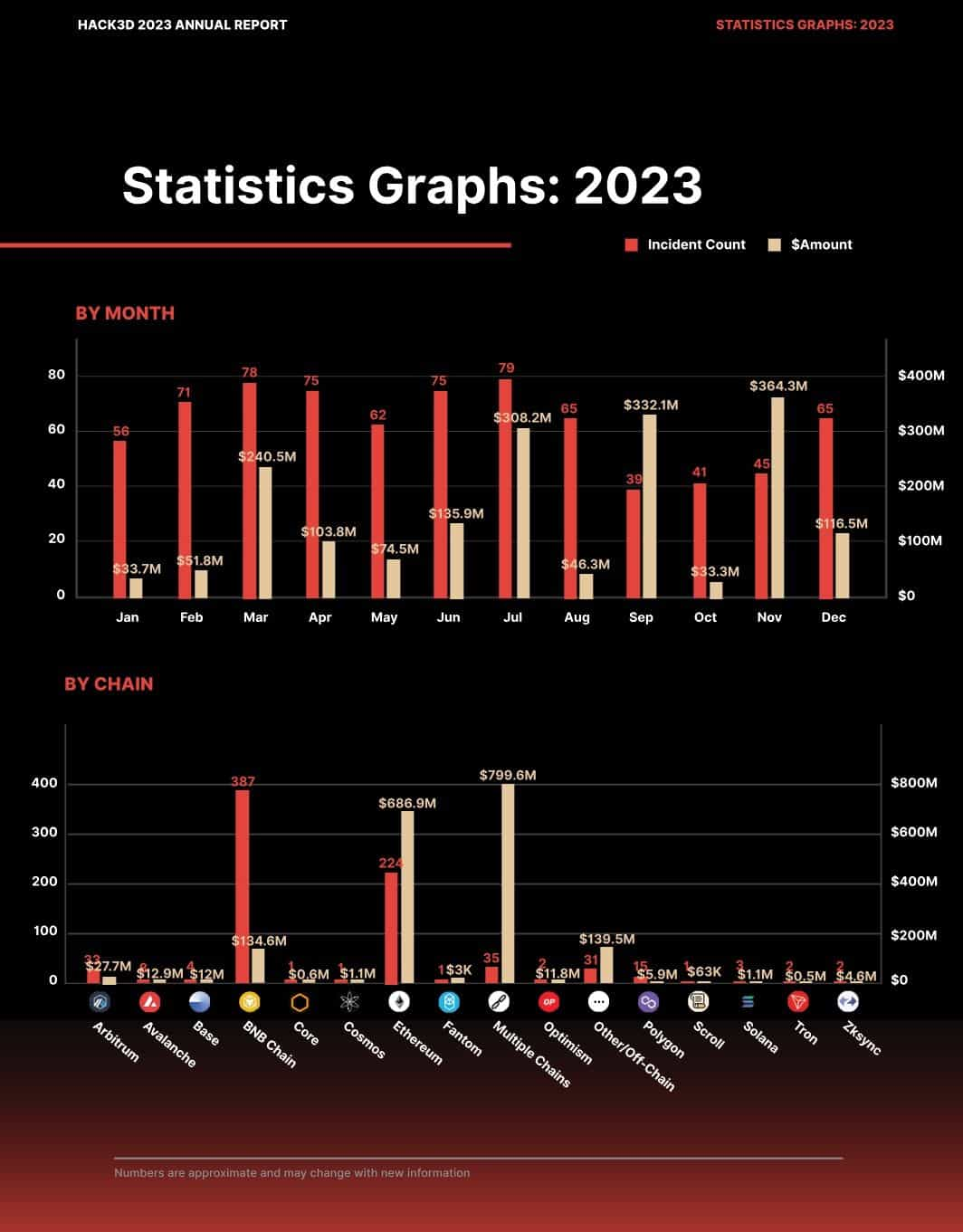
The biggest hacks in 2023 included:
- Mixin: $200 million
- Euler Finance: $197 million
- Poloniex: $126 million
- Atomic wallet: $100 million
- Curve: $60 million
Addressing these security concerns involves a multifaceted approach that includes leveraging specialized custodial services, ensuring regulatory compliance and exploring self-custody solutions.
Reputational Risk
Blockchain technology has come a long way. Still, cryptocurrencies are often associated with volatility and speculative trading, which may pose a reputational risk for institutions.
Reputational risk is a subtle menace that can jeopardize even the most well-managed corporations. This risk leads to repercussions that defy straightforward measurement. Nevertheless, its impact can detrimentally influence a company's bottom line and stock price.
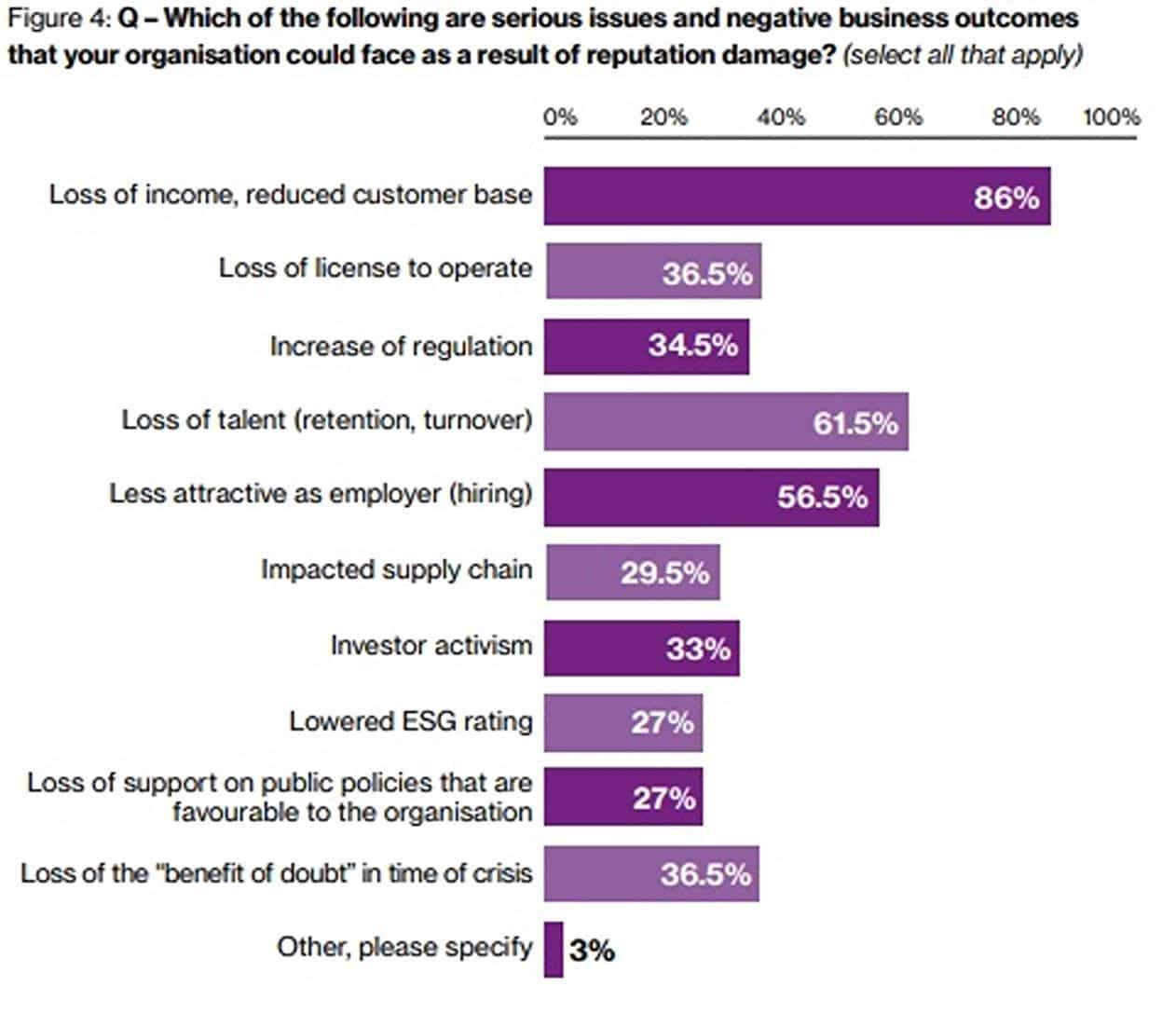
Cryptocurrencies carry a speculative narrative that contrasts with the conservative approach favoured by many institutional investors. Their association with certain illicit activities, facilitated by perceived anonymity and decentralization, has also contributed to negative perceptions.
According to Chainalysis, illicit transaction volume in 2022 rose for the second consecutive year, hitting an all-time high of $20.1 billion. Forty-four per cent of the total came from activity associated with sanctioned entities.
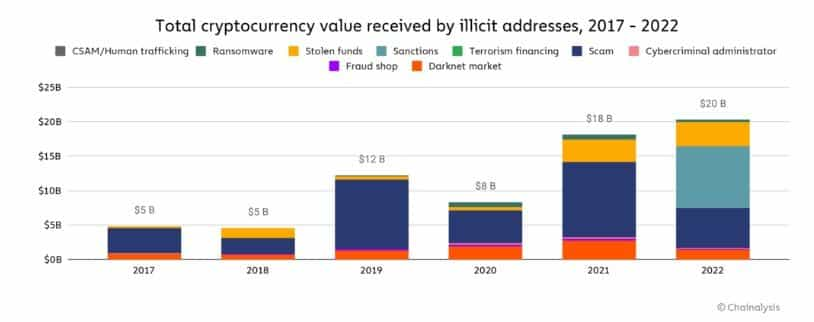
What's Next for Institutional Crypto Interest?
Institutional interest in crypto is set to reshape the future landscape of finance as Wall Street ditches its “praise the sea, on shore remain” mantra and is now increasingly drawn into the cryptoverse.
The surge in institutional adoption is poised to usher in a wave of fresh investments through the introduction of innovative institutional crypto products. The shift gained notable momentum with the launch of the first Bitcoin Futures ETF in the U.S. in 2021. While this ETF was futures-based rather than tied to the bitcoin spot market, its inception marked a significant stride in the right direction. Of course, more than 12 companies have filed applications with the SEC for a spot Bitcoin ETF.
The growing appetite among institutional investors for conventional financial products tied to crypto is driving the creation of new offerings, resulting in an influx of investments.
Speaking of, crypto VC funding took a beating in 2023, falling by 68% in 2023 to $10.7 billion, compared to $33.3 billion in 2022, according to The Block. Still, the total outpaces prior bear markets, exceeding the $6.4 billion invested in 2019 and 2020.
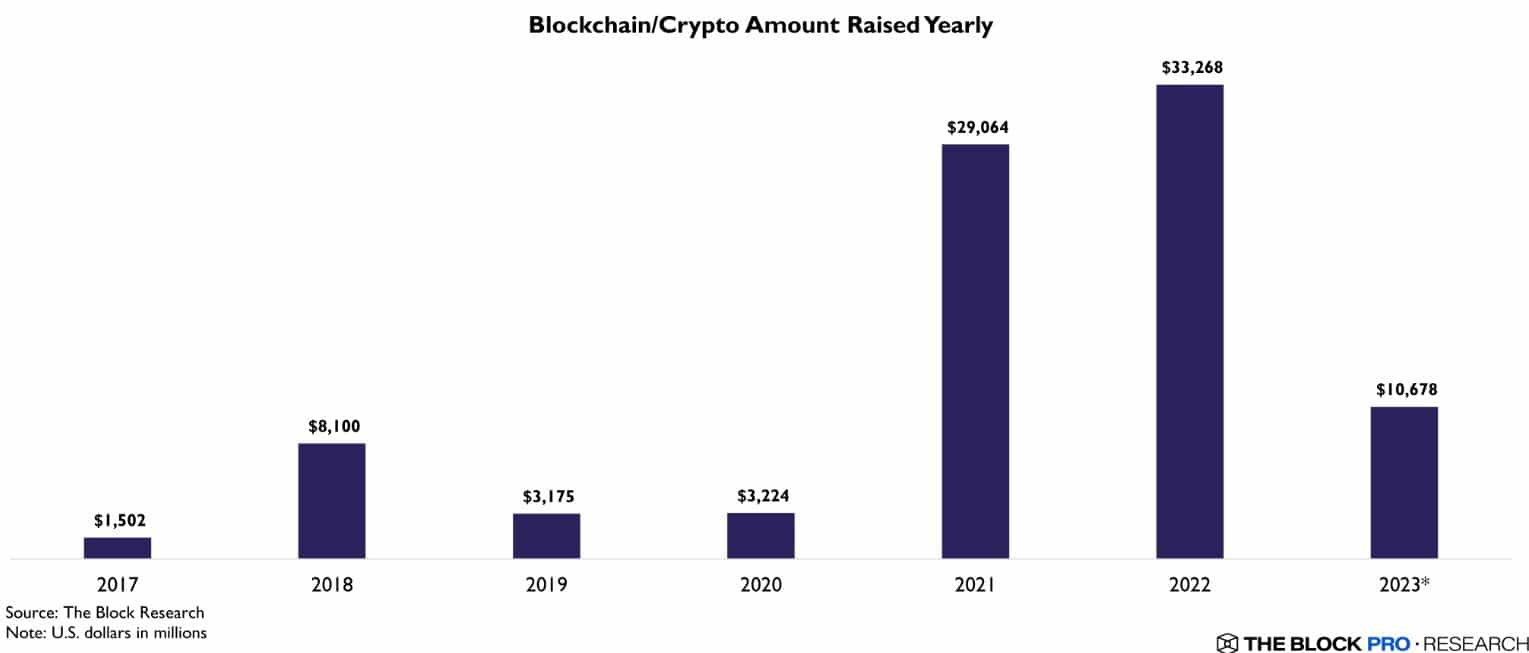
As the cryptocurrency market continues to mature, institutional involvement is likely to increase due to factors including:
- The continued development of regulatory frameworks is expected to provide institutions with clearer guidelines.
- The highly anticipated approval and launch of spot Bitcoin and Ether exchange-traded funds in the U.S.
- The evolution of DeFi and the continued advancements in blockchain technology.
Emerging Trends and Potential Catalysts
There are a few emerging trends that should act as catalysts for heightened institutional participation in the crypto market.
Tokenization
One notable trend is the growing interest in tokenization of real-world assets. Tokenization, a process involving the issuance of a digital representation of an asset, has emerged as the new crypto buzzword. The spectrum of tokenized assets spans physical items like real estate or art, financial instruments such as equities or bonds, intangible assets like intellectual property, and even personal identifiers and data.
The potential impact of tokenization is significant. Industry experts project a substantial surge, with forecasts predicting up to $5 trillion in tokenized digital-securities trade volume by 2030.
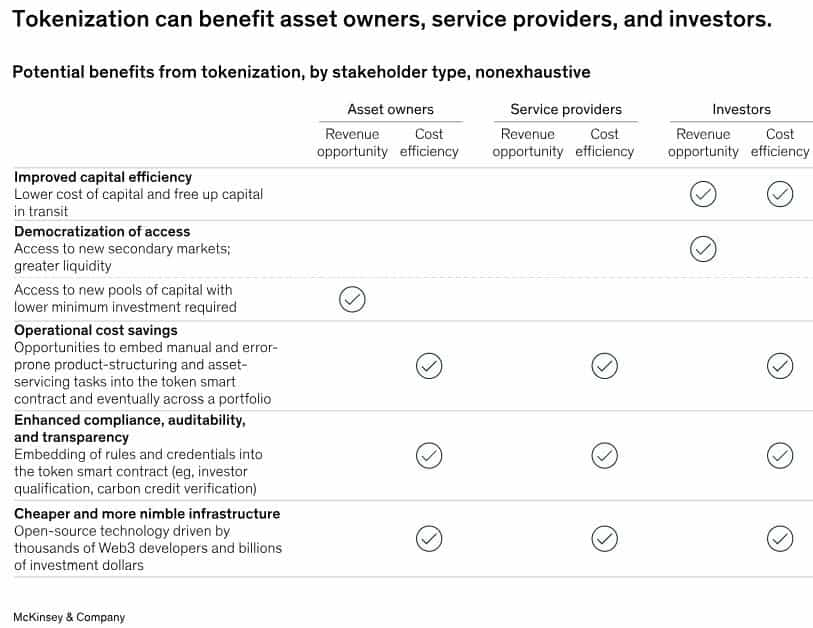
While the concept of digital-asset tokenization has garnered attention since its introduction in 2017, its widespread adoption has lagged. Despite persistent hype, meaningful traction has been slow to develop.
Regulatory Clarity
Any discussion in the crypto realm is incomplete without some regulatory cherry on top!
Increased regulatory clarity holds the key to unlocking a new chapter in the adoption of cryptocurrencies by major institutions. As the regulatory landscape for digital assets becomes more defined, major players in the financial industry will likely find greater comfort and confidence in navigating the crypto space. Regulatory clarity addresses longstanding concerns surrounding compliance, legal frameworks, and risk mitigation, which have traditionally been deterrents for institutional involvement in the crypto market.
The EU is far ahead of most geographies when it comes to regulating the crypto market. In April 2023, the EU passed the Markets in Crypto-Assets Regulation (MiCA), which was met with great fanfare. French Finance Minister Bruno Le Maire called it a “landmark" law, while now-former Binance CEO Changpeng Zhao welcomed the “clear rules of the game.”
Here's a neat table, courtesy of CoinDesk, that lays out the basics of MiCA.
| The Good | The Bad |
|---|---|
| Legal certainty | Tough rules to meet |
| Rules tailored to fit crypto | Million-euro fines for getting it wrong |
| Credibility to wary customers | Caps on USD stablecoins |
| One license to operate across the bloc | NFTs are a grey area |
| Attract TradFi investment | Unclear how overseas enforcement will work |
The U.S. is at a crossroads when it comes to crypto regulation. Regulation by enforcement fails to provide needed clarity or protect consumers while chilling innovation. - Gemini
The shift from uncertainty to regulatory clarity is a pivotal step that could open the floodgates for substantial institutional participation in the crypto market.
Closing Thoughts
Wall Street's crypto narrative has evolved from cautious observation to active participation.
The eye-popping returns offered by cryptocurrencies have served as a compelling catalyst for institutions to re-evaluate their initial scepticism. This shift isn't necessarily about fattening their balance sheets but potentially signifies a broader acknowledgement of blockchain technology's potential. This attention plays a pivotal role in legitimizing the crypto market as a whole, dispelling the notion of digital assets as purely speculative.
Looking ahead, the future outlook for institutional crypto interest appears promising. Predictions hint at a deeper integration of digital assets into institutional portfolios, driven by regulatory developments, the launch of spot exchange-traded funds, and advancements in decentralized finance. Emerging trends, such as tokenization, present additional opportunities.
As Wall Street embraces cryptocurrencies, the journey from scepticism to active exploration sets the stage for a new era in finance.
Frequently Asked Questions
Wall Street's attention in the cryptocurrency realm centres around two key players: Bitcoin and Ethereum.
- Bitcoin: Renowned as "digital gold," Bitcoin is witnessing increased institutional adoption. The emergence of regulated investment vehicles, like Bitcoin exchange-traded funds (ETFs) and pending spot ETF applications, provides a secure and familiar entry point for institutions. Bitcoin's outstanding performance, outpacing traditional assets, has instilled confidence and drawn institutional interest.
- Ethereum: As the second-largest cryptocurrency, Ethereum is gaining institutional traction due to its smart contracts and role in decentralized finance (DeFi). The platform's dominance in the non-fungible token (NFT) space further attracts institutional attention. The filing of spot Ether ETFs by major companies underscores the growing interest in Ethereum among institutional investors.
Institutional investors are increasingly drawn to cryptocurrencies due to several factors. Eye-popping returns on investment, particularly in assets like Bitcoin, have caught the attention of major institutions. Additionally, the legitimization of the crypto market, increased market credibility, and the potential for diversification are contributing to institutional interest.
Regulatory clarity is a significant catalyst for institutional involvement in cryptocurrencies. As regulatory frameworks become more defined, major institutions gain confidence and comfort navigating the crypto space. Clear guidelines address compliance concerns, legal frameworks, and risk mitigation, making it easier for institutions to assess the risks and benefits associated with crypto investments.
Institutional investors face various challenges in entering the crypto market, including regulatory uncertainty, security concerns, and reputational risks. The lack of a standardized regulatory framework introduces ambiguity, security remains a paramount concern due to hacking incidents, and the association of cryptocurrencies with volatility poses reputational risks for institutions.
Bitcoin has maintained its position as the largest cryptocurrency and is often viewed as "digital gold." Institutions are drawn to Bitcoin for its decentralized nature and finite supply, making it attractive during economic uncertainties. Ethereum, on the other hand, appeals to institutions due to its unique features, such as smart contracts and its pivotal role in decentralized finance (DeFi) and non-fungible tokens (NFTs).
The long-term impact of institutional crypto interest on the broader financial landscape is profound. It signals a fusion of traditional finance and the crypto market, reshaping how assets are managed, traded, and valued globally. The transformative potential lies in the convergence of innovation and legitimacy, paving the way for a more inclusive and resilient financial ecosystem.
Disclaimer: These are the writer’s opinions and should not be considered investment advice. Readers should do their own research.


